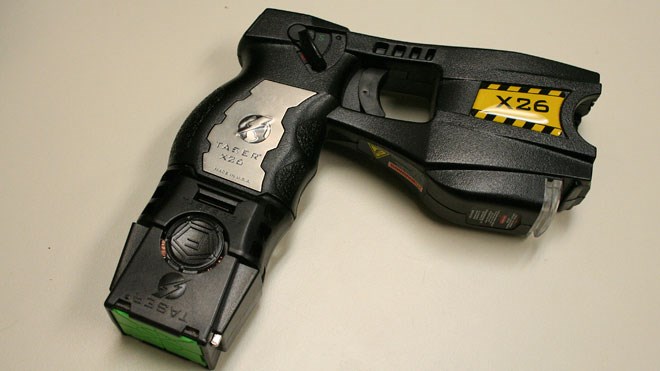Greater Sudbury's Police Services Board is planning a public meeting to get community input on a plan to increase the number and use of stun guns in the city.
Meeting Sept. 11, Chief Frank Elsner said there's a lot of misinformation in the community about Tasers, particularly since a 2007 incident in Vancouver. Police used a Taser to try and subdue a man at the airport, who later died of a heart attack.
That led many in the public to view them as especially dangerous, when the opposite is true, he said. Using pepper spray or a baton to subdue a violent suspect is far more dangerous, Elsner said. You have to hit someone with a baton, and pepper spray is dangerous to both the suspect and the officer using it.
With Tasers – or conducted energy weapons – as soon as you power it up, it makes a loud sound. Once suspects hear that noise, Elsner said they usually stop resisting rather than risk getting shocked.
“People in that community know what (that sound) is all about, so we get compliance without it actually being used,” Elser said. “So what we're finding is that an overwhelming amount of people don't want it used on them ... That's fantastic – we get instant compliance.”
In Sudbury, police are aiming to buy about 40 Tasers, at a cost of $2,000 each, when the holsters and other accessories are included. But when Community Safety Minister Madeleine Meilleur approved the wider use of Tasers by police on Aug. 27, Elsner said the announcement didn't include funding either to buy the equipment or train officers.
Board member Gerry Lougheed Jr. suggested a public-private sector partnership could be a way to get the Tasers quickly while not affecting the police budget. If the province is willing to pay for training, he said he'll lead an effort to get 40 local businesses to “buy” a taser for use by police.
“That's so doable, we could probably raise $80,000 over the next month if we wanted to,” he said. “But if the community buys the Tasers, then the government has to pay for the training.”
He also suggested holding the public meeting, which would be hosted by chair Ron Dupuis and the rest of the board. It would be modelled on one-on Taser use being held in Toronto on Sept. 24.
He suggested Sudbury do the same, with board members getting input from the public on their concerns and opinions.
“And when we hear that, we would give you that feedback,” Lougheed said.
Mayor Marianne Matichuk said when she worked in health and safety, she regularly saw law enforcement officers who were injured during violent arrests and who were forced to miss work with shoulder and back injuries.
The average cost of a WSIB claim is $80,000, Matichuk said. So Tasers are both a good investment and a way of keeping officers safe.
“This is going to help ensure our employees don't get hurt,” she said.
Elsner said arresting someone who is violent or mentally unstable is far more dangerous in reality than it's portrayed in movies or television. It's an unpleasant and ugly experience for all involved, and often leads to injuries. Yet he had someone ask him recently why police can't just shoot knives out of people's hands.
“That's not reality,” he said. “Sometimes, this is a dirty business.”
Join Sudbury.com+
- Messages
- Post a Listing
- Your Listings
- Your Profile
- Your Subscriptions
- Your Likes
- Your Business
- Support Local News
- Payment History
Sudbury.com+ members
Already a +member?
Not a +member?
Sign up for a Sudbury.com+ account for instant access to upcoming contests, local offers, auctions and so much more.



